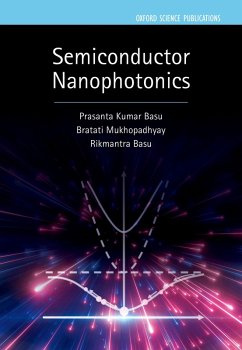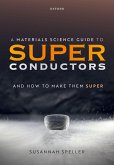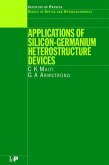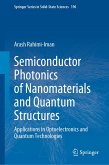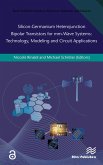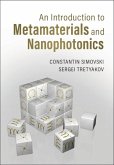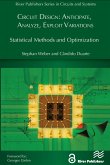

Alle Infos zum eBook verschenken

- Format: PDF
- Merkliste
- Auf die Merkliste
- Bewerten Bewerten
- Teilen
- Produkt teilen
- Produkterinnerung
- Produkterinnerung

Hier können Sie sich einloggen

Bitte loggen Sie sich zunächst in Ihr Kundenkonto ein oder registrieren Sie sich bei bücher.de, um das eBook-Abo tolino select nutzen zu können.
Nanometre sized structures made of semiconductors, insulators, and metals and grown by modern growth technologies or by chemical synthesis exhibit novel electronic and optical phenomena due to the confinement of electrons and photons. Strong interactions between electrons and photons in narrow regions lead to inhibited spontaneous emission, thresholdless laser operation, and Bose-Einstein condensation of exciton-polaritons in microcavities. Generation of sub-wavelength radiation by surface plasmon-polaritons at metal-semiconductor interfaces, creation of photonic band gaps in dielectrics, and…mehr
- Geräte: PC
- mit Kopierschutz
- eBook Hilfe
- Größe: 5.71MB
![A Materials Science Guide to Superconductors (eBook, PDF) A Materials Science Guide to Superconductors (eBook, PDF)]() Susannah SpellerA Materials Science Guide to Superconductors (eBook, PDF)21,95 €
Susannah SpellerA Materials Science Guide to Superconductors (eBook, PDF)21,95 €![Circuits and Systems for Wearable Technologies (eBook, PDF) Circuits and Systems for Wearable Technologies (eBook, PDF)]() Circuits and Systems for Wearable Technologies (eBook, PDF)71,95 €
Circuits and Systems for Wearable Technologies (eBook, PDF)71,95 €![Applications of Silicon-Germanium Heterostructure Devices (eBook, PDF) Applications of Silicon-Germanium Heterostructure Devices (eBook, PDF)]() C. K MaitiApplications of Silicon-Germanium Heterostructure Devices (eBook, PDF)239,95 €
C. K MaitiApplications of Silicon-Germanium Heterostructure Devices (eBook, PDF)239,95 €![Semiconductor Photonics of Nanomaterials and Quantum Structures (eBook, PDF) Semiconductor Photonics of Nanomaterials and Quantum Structures (eBook, PDF)]() Arash Rahimi-ImanSemiconductor Photonics of Nanomaterials and Quantum Structures (eBook, PDF)160,49 €
Arash Rahimi-ImanSemiconductor Photonics of Nanomaterials and Quantum Structures (eBook, PDF)160,49 €![Silicon-Germanium Heterojunction Bipolar Transistors for Mm-wave Systems Technology, Modeling and Circuit Applications (eBook, PDF) Silicon-Germanium Heterojunction Bipolar Transistors for Mm-wave Systems Technology, Modeling and Circuit Applications (eBook, PDF)]() Silicon-Germanium Heterojunction Bipolar Transistors for Mm-wave Systems Technology, Modeling and Circuit Applications (eBook, PDF)0,99 €
Silicon-Germanium Heterojunction Bipolar Transistors for Mm-wave Systems Technology, Modeling and Circuit Applications (eBook, PDF)0,99 €![Introduction to Metamaterials and Nanophotonics (eBook, PDF) Introduction to Metamaterials and Nanophotonics (eBook, PDF)]() Constantin SimovskiIntroduction to Metamaterials and Nanophotonics (eBook, PDF)41,95 €
Constantin SimovskiIntroduction to Metamaterials and Nanophotonics (eBook, PDF)41,95 €![Circuit Design (eBook, PDF) Circuit Design (eBook, PDF)]() Stephan WeberCircuit Design (eBook, PDF)0,99 €
Stephan WeberCircuit Design (eBook, PDF)0,99 €-
-
-
Dieser Download kann aus rechtlichen Gründen nur mit Rechnungsadresse in A, B, BG, CY, CZ, D, DK, EW, E, FIN, F, GR, HR, H, IRL, I, LT, L, LR, M, NL, PL, P, R, S, SLO, SK ausgeliefert werden.
- Produktdetails
- Verlag: Oxford University Press
- Seitenzahl: 496
- Erscheinungstermin: 5. April 2022
- Englisch
- ISBN-13: 9780191087622
- Artikelnr.: 63634892
- Verlag: Oxford University Press
- Seitenzahl: 496
- Erscheinungstermin: 5. April 2022
- Englisch
- ISBN-13: 9780191087622
- Artikelnr.: 63634892
* Acknowledgements
* Chapter 1: Introduction
* 1.1: Introduction to Nanophotonics
* 1.2: Nanophotonics : Scope
* 1.3: Introduction to Nanostructures
* 1.4: Novel Phenomena in Nanophotonics: A Brief Outline
* 1.5: Applications of Nanophotonics
* 1.6: Problems of Integration
* Chapter 2: Basic Properties of Semiconductors
* 2.1: Introduction
* 2.2: Band Structure
* 2.3: Density of States
* 2.4: Doping
* 2.5: Carrier Concentration
* 2.6: Carrier Concentration
* 2.7: Excess Carriers and Recombination
* 2.8: Excitons
* 2.9: Alloys and Heterojunctions
* 2.10: Quantum Structures
* 2.11: Strained Layers
* Chapter 3: Macroscopic Theory of Optical Processes
* 3.1: Introduction
* 3.2: Optical Constants
* 3.3: Phase and Group Velocities
* 3.4: Susceptibility of a Material: a Classical Model
* 3.5: Einstein's Model for Light-Matter Interaction
* Chapter 4: Photons and Electron-photon Interactions
* 4.1: Introduction
* 4.2: Wave Equation in a Rectangular Cavity
* 4.3: Quantization of the Radiation Field
* 4.4: Time Dependent Perturbation Theory
* 4.5: Interaction of an Electron with the Electromagnetic Field
* 4.6: Second Order Perturbation Theory
* Chapter 5: Electron Photon Interactions in Bulk Semiconductors
* 5.1: Introduction
* 5.2: Absorption Processes in Semiconductors
* 5.3: Fundamental Absorption in Direct gap
* 5.4: Intervalence Band Absorption
* 5.5: Free Carrier Absorption
* 5.6: Recombination and Luminescence
* 5.7: NonradiativeRecombination
* 5.8: Carrier Effect on Absorption and Refractive Index
* 5.9: Gain in Semiconductors
* Chapter 6: Optical Processes in QWs
* 6.1: Introduction
* 6.2: Optical Processes in QWs
* 6.3: Interband Absorption
* 6.4: Intersubband Absorption
* 6.5: Recombination in QWs
* 6.6: Loss Processes in QWs
* 6.7: Gain in QWs
* 6.8: Strained QW Lasers
* Chapter 7: Excitons in Bulk Semiconductors and QWs
* 7.1: Introduction
* 7.2: Excitons in Bulk Semiconductors
* 7.3: Excitonic Processes in QWs
* 7.4: Line Broadening Mechanisms for 2D Excitons
* 7.5: Effect of Electric Field in Semiconductors
* 7.6: Excitonic Characteristics in Fractional Dimensional Space
* Chapter 8: Nanowires
* 8.1: Introduction
* 8.2: Quantum Wires: Preliminaries
* 8.3: Excitonic Processes in QWRs
* 8.4: Classification of Nanowires
* 8.5: Growth of QWRs
* 8.6: Nanowires
* 8.7: Properties of NWRs
* 8.8: Applications of NWRs
* Chapter 9: Nanoparticles
* 9.1: Introduction
* 9.2: Quantum Dots
* 9.3: QD Growth Mechanisms and Structures
* 9.4: Zero Dimensional Systems
* 9.5: Deviation from Simple Theory: Effect of Broadening
* 9.6: QD Lasers : Structure and Gain Calculation
* 9.7: Intersubband Transitions
* 9.8: Excitonic Processes in QDs
* 9.9: Classification of Nanocrystals
* 9.10: Synthesis of Nanocrystals
* 9.11: Core-Shell Structures
* 9.12: Bright and Dark Excitons
* 9.13: Biexcitons and Trions
* 9.14: Applications
* Chapter 10: Microcavity
* 10.1: Introduction
* 10.2: Cavity Fundamentals
* 10.3: Fabry-Perot Resonators
* 10.4: Bragg Gratings and Bragg Mirrors
* 10.5: Ring Resonators
* 10.6: Whispering Gallery Mode Resonators
* 10.7: Wave Propagation in Periodic Structures: Photonic Crystals
* 10.8: Micropillar
* 10.9: Characteristics of Microcavity
* Chapter 11: Cavity Quantum Elecrodynamics
* 11.1: Introduction
* 11.2: Zero-Point Energy and Vacuum Field
* 11.3: Control of Spontaneous Emission
* 11.4: Mode Density in Ideal Cavities
* 11.5: Experimental Observation of Purcell Effect
* 11.6: Strong Light-Matter Coupling
* 11.7: Jaynes-Cummins Model
* 11.8: Microcavities in CQED Experiments
* 11.9: Applications
* 11.10: Microcavity Laser
* Chapter 12: Bose Einstein Condensation
* 12.1: Introduction
* 12.2: Elements of Bose Einstein Condensation
* 12.3: BEC in Semiconductors
* 12.4: Bulk Excitons
* 12.5: Indirect Excitons in Coupled QWs
* 12.6: Polariton
* 12.7: Polariton Lasers
* 12.8: Modeling of Electrically Driven Polariton Laser
* Chapter 13: Surface Plasmons
* 13.1: Introduction
* 13.2: Basic Concepts
* 13.3: Surface Plasmon Polaritons at Metal/Insulator Interfaces
* 13.4: Excitation Mechanism
* 13.5: Materials
* 13.6: Length Scales in Noble Metals
* 13.7: Metal-insulator Based Plasmonics-photonics
* 13.8: All Semiconductor Plasmonics
* 13.9: Plasmonic Properties of Semiconductors
* 13.10: Components: source, modulators, waveguides, detector
* 13.11: Application of Plasmonics in VLSI, Data Centres and
Supercomputers
* 13.12: Applications of Surface Plasmons in Basic Science and
Characterization
* 13.13: Intersubband Plasmons
* Chapter 14: Spasers and Plasmonic Nanolasers
* 14.1: Introduction
* 14.2: Early Investigations on SP Amplification
* 14.3: Models for Noginov et al Experiment
* 14.4: Semiconductor Spasers and Plasmonic Nanolasers
* 14.5: Theoretical Models by Khurgin and Sun
* 14.6: Current Theoretical Models and Experiments
* 14.7: Further Developments
* Chapter 15: Optical Metamaterials
* 15.1: Introduction
* 15.2: Left Handed Material with Negative RI
* 15.3: Structures for Microwaves
* 15.4: Perfect Lens
* 15.5: NIR with Positive Permittivity and Permeability
* 15.6: Low Loss Plasmonic Metamaterial
* 15.7: Semiconductor Metamaterials
* 15.8: Metasurfaces
* 15.9: Beam Steering
* Chapter 16: Nanolasers
* 16.1: Introduction
* 16.2: Parameters of Lasers
* 16.3: Progress in Nanolasers
* 16.4: Threshold Pump Power of Nanolasers: Purcell Effect
* 16.5: Intrinsic Merit of Nanolasers
* 16.6: Optical Interconnect
* 16.7: Metal Based Nanolasers
* Acknowledgements
* Chapter 1: Introduction
* 1.1: Introduction to Nanophotonics
* 1.2: Nanophotonics : Scope
* 1.3: Introduction to Nanostructures
* 1.4: Novel Phenomena in Nanophotonics: A Brief Outline
* 1.5: Applications of Nanophotonics
* 1.6: Problems of Integration
* Chapter 2: Basic Properties of Semiconductors
* 2.1: Introduction
* 2.2: Band Structure
* 2.3: Density of States
* 2.4: Doping
* 2.5: Carrier Concentration
* 2.6: Carrier Concentration
* 2.7: Excess Carriers and Recombination
* 2.8: Excitons
* 2.9: Alloys and Heterojunctions
* 2.10: Quantum Structures
* 2.11: Strained Layers
* Chapter 3: Macroscopic Theory of Optical Processes
* 3.1: Introduction
* 3.2: Optical Constants
* 3.3: Phase and Group Velocities
* 3.4: Susceptibility of a Material: a Classical Model
* 3.5: Einstein's Model for Light-Matter Interaction
* Chapter 4: Photons and Electron-photon Interactions
* 4.1: Introduction
* 4.2: Wave Equation in a Rectangular Cavity
* 4.3: Quantization of the Radiation Field
* 4.4: Time Dependent Perturbation Theory
* 4.5: Interaction of an Electron with the Electromagnetic Field
* 4.6: Second Order Perturbation Theory
* Chapter 5: Electron Photon Interactions in Bulk Semiconductors
* 5.1: Introduction
* 5.2: Absorption Processes in Semiconductors
* 5.3: Fundamental Absorption in Direct gap
* 5.4: Intervalence Band Absorption
* 5.5: Free Carrier Absorption
* 5.6: Recombination and Luminescence
* 5.7: NonradiativeRecombination
* 5.8: Carrier Effect on Absorption and Refractive Index
* 5.9: Gain in Semiconductors
* Chapter 6: Optical Processes in QWs
* 6.1: Introduction
* 6.2: Optical Processes in QWs
* 6.3: Interband Absorption
* 6.4: Intersubband Absorption
* 6.5: Recombination in QWs
* 6.6: Loss Processes in QWs
* 6.7: Gain in QWs
* 6.8: Strained QW Lasers
* Chapter 7: Excitons in Bulk Semiconductors and QWs
* 7.1: Introduction
* 7.2: Excitons in Bulk Semiconductors
* 7.3: Excitonic Processes in QWs
* 7.4: Line Broadening Mechanisms for 2D Excitons
* 7.5: Effect of Electric Field in Semiconductors
* 7.6: Excitonic Characteristics in Fractional Dimensional Space
* Chapter 8: Nanowires
* 8.1: Introduction
* 8.2: Quantum Wires: Preliminaries
* 8.3: Excitonic Processes in QWRs
* 8.4: Classification of Nanowires
* 8.5: Growth of QWRs
* 8.6: Nanowires
* 8.7: Properties of NWRs
* 8.8: Applications of NWRs
* Chapter 9: Nanoparticles
* 9.1: Introduction
* 9.2: Quantum Dots
* 9.3: QD Growth Mechanisms and Structures
* 9.4: Zero Dimensional Systems
* 9.5: Deviation from Simple Theory: Effect of Broadening
* 9.6: QD Lasers : Structure and Gain Calculation
* 9.7: Intersubband Transitions
* 9.8: Excitonic Processes in QDs
* 9.9: Classification of Nanocrystals
* 9.10: Synthesis of Nanocrystals
* 9.11: Core-Shell Structures
* 9.12: Bright and Dark Excitons
* 9.13: Biexcitons and Trions
* 9.14: Applications
* Chapter 10: Microcavity
* 10.1: Introduction
* 10.2: Cavity Fundamentals
* 10.3: Fabry-Perot Resonators
* 10.4: Bragg Gratings and Bragg Mirrors
* 10.5: Ring Resonators
* 10.6: Whispering Gallery Mode Resonators
* 10.7: Wave Propagation in Periodic Structures: Photonic Crystals
* 10.8: Micropillar
* 10.9: Characteristics of Microcavity
* Chapter 11: Cavity Quantum Elecrodynamics
* 11.1: Introduction
* 11.2: Zero-Point Energy and Vacuum Field
* 11.3: Control of Spontaneous Emission
* 11.4: Mode Density in Ideal Cavities
* 11.5: Experimental Observation of Purcell Effect
* 11.6: Strong Light-Matter Coupling
* 11.7: Jaynes-Cummins Model
* 11.8: Microcavities in CQED Experiments
* 11.9: Applications
* 11.10: Microcavity Laser
* Chapter 12: Bose Einstein Condensation
* 12.1: Introduction
* 12.2: Elements of Bose Einstein Condensation
* 12.3: BEC in Semiconductors
* 12.4: Bulk Excitons
* 12.5: Indirect Excitons in Coupled QWs
* 12.6: Polariton
* 12.7: Polariton Lasers
* 12.8: Modeling of Electrically Driven Polariton Laser
* Chapter 13: Surface Plasmons
* 13.1: Introduction
* 13.2: Basic Concepts
* 13.3: Surface Plasmon Polaritons at Metal/Insulator Interfaces
* 13.4: Excitation Mechanism
* 13.5: Materials
* 13.6: Length Scales in Noble Metals
* 13.7: Metal-insulator Based Plasmonics-photonics
* 13.8: All Semiconductor Plasmonics
* 13.9: Plasmonic Properties of Semiconductors
* 13.10: Components: source, modulators, waveguides, detector
* 13.11: Application of Plasmonics in VLSI, Data Centres and
Supercomputers
* 13.12: Applications of Surface Plasmons in Basic Science and
Characterization
* 13.13: Intersubband Plasmons
* Chapter 14: Spasers and Plasmonic Nanolasers
* 14.1: Introduction
* 14.2: Early Investigations on SP Amplification
* 14.3: Models for Noginov et al Experiment
* 14.4: Semiconductor Spasers and Plasmonic Nanolasers
* 14.5: Theoretical Models by Khurgin and Sun
* 14.6: Current Theoretical Models and Experiments
* 14.7: Further Developments
* Chapter 15: Optical Metamaterials
* 15.1: Introduction
* 15.2: Left Handed Material with Negative RI
* 15.3: Structures for Microwaves
* 15.4: Perfect Lens
* 15.5: NIR with Positive Permittivity and Permeability
* 15.6: Low Loss Plasmonic Metamaterial
* 15.7: Semiconductor Metamaterials
* 15.8: Metasurfaces
* 15.9: Beam Steering
* Chapter 16: Nanolasers
* 16.1: Introduction
* 16.2: Parameters of Lasers
* 16.3: Progress in Nanolasers
* 16.4: Threshold Pump Power of Nanolasers: Purcell Effect
* 16.5: Intrinsic Merit of Nanolasers
* 16.6: Optical Interconnect
* 16.7: Metal Based Nanolasers
